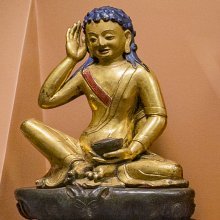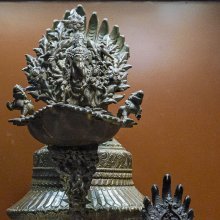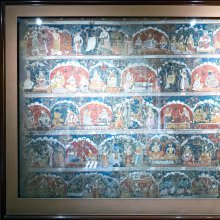Cotton: 2 definitions
Introduction:
Cotton means something in the history of ancient India, biology. If you want to know the exact meaning, history, etymology or English translation of this term then check out the descriptions on this page. Add your comment or reference to a book if you want to contribute to this summary article.
Images (photo gallery)
India history and geography
Source: Knowledge Traditions & Practices of India: Other Technologies: A SurveyCotton refers to a textile that was actively produced and exported in ancient India.—By the time trade with the Roman Empire reached its peak, India was a major exporter of textiles (e.g., Cotton), specially cotton and silk. The Vedas refer to various types of garments as well as fabrics such as wool (avi, śāmulya) or silk (tarpya), also to weaving and looms. Later on, cotton appears (karpāsa) and we get some information on weaving skills from Buddhist literature.
From the 5th century CE), hoards of fragments of cotton material from Gujarat were found in Egyptian tombs at Fustat. India exported cotton to China, silk to Indonesia and all the way to the Far East. Fabrics — especially cotton and silk — often provided supports for much painted, printed or embroidered artwork (see an example left, from Gujarat), whether the resulting piece was to be worn as a sari or brocade or hung as tapestry.

The history of India traces the identification of countries, villages, towns and other regions of India, as well as mythology, zoology, royal dynasties, rulers, tribes, local festivities and traditions and regional languages. Ancient India enjoyed religious freedom and encourages the path of Dharma, a concept common to Buddhism, Hinduism, and Jainism.
Biology (plants and animals)
Source: Google Books: CRC World Dictionary (Regional names)1) Cotton in English is the name of a plant defined with Gossypium arboreum in various botanical sources. This page contains potential references in Ayurveda, modern medicine, and other folk traditions or local practices It has the synonym Gossypium arboreum Parl. (among others).
2) Cotton is also identified with Gossypium herbaceum It has the synonym Gossypium zaitzevii Prokh. (etc.).
3) Cotton is also identified with Gossypium hirsutum It has the synonym Gossypium hirsutum fo. punctatum (Schumach. & Thonn.) Roberty (etc.).
Example references for further research on medicinal uses or toxicity (see latin names for full list):
· Florae Senegambiae Tentamen (1831)
· Scientia Agricultura Sinica (1992)
· The Gardeners Dictionary (1754)
· Fl. Antil. (1818)
· The Wild and Cultivated Cotton Plants of the World (1907)
· China Cottons (1984)
If you are looking for specific details regarding Cotton, for example side effects, chemical composition, extract dosage, health benefits, pregnancy safety, diet and recipes, have a look at these references.

This sections includes definitions from the five kingdoms of living things: Animals, Plants, Fungi, Protists and Monera. It will include both the official binomial nomenclature (scientific names usually in Latin) as well as regional spellings and variants.
See also (Relevant definitions)
Starts with: Cotton grass, Cotton gum, Cotton leaf, Cotton milkbush, Cotton palm, Cotton plant, Cotton rose, Cotton thistle, Cotton tree, Cotton-leaved jatropha, Cotton-weed, Cotton-wool grass, Cottonleaved physic nut, Cottonweed, Cottonwood, Cottonwood tree, Cottony jujube.
Ends with: American upland cotton, Balloon cotton, Chinese cotton, Common cotton, Cultivated cotton, English cotton, French cotton, Indian tree cotton, Lavender-cotton, Levant cotton, Marshy silk cotton, Peru cotton, Red cotton, Sea island cotton, Silk-cotton, Tree cotton, Upland cotton, Wild cotton.
Full-text (+1047): Karpasa, Tulapicu, Tulaka, Picu, Shalmali, Picavya, Tulika, Tula, Tulini, Apurani, Tundikeri, Vanga, Vastrayoni, Badara, Kutashalmali, Karpasasthi, Pinjika, Indratula, Suti, Girani.
Relevant text
Search found 178 books and stories containing Cotton; (plurals include: Cottons). You can also click to the full overview containing English textual excerpts. Below are direct links for the most relevant articles:
Vinaya Pitaka (1): Bhikkhu-vibhanga (the analysis of Monks’ rules) (by I. B. Horner)
Maha Prajnaparamita Sastra (by Gelongma Karma Migme Chödrön)
III. Material benefits granted by the Bodhisattva < [Part 2 - Fulfilling the wishes of all beings]
I. Surpassing the stage of Śrāvaka and Pratyekabuddha < [X. Surpassing the lower vehicles and acceding to the irreversible ground]
Part 8 - Jātaka of the king who set fire to his body so as to hear a Buddhist stanza < [Chapter XIX - The Characteristics of Generosity]
Cosmetics, Costumes and Ornaments in Ancient India (by Remadevi. O.)
1. Materials for Garments (b): Cotton cloth from Fruit fibers < [Chapter 2 - Costumes]
7. Trade and Commerce (of clothes and dresses) < [Chapter 2 - Costumes]
3.6. Dress Making: Washing < [Chapter 2 - Costumes]
Village Folk-tales of Ceylon (Sri Lanka), vol. 1-3 (by Henry Parker)
Sir Arthur Cotton – A Noble Work of God < [July – September, 2005]
Jamsetji, the Pioneer < [July 1937]
Song of the Indian Peasant < [Aug - Sept 1939]
The Jataka tales [English], Volume 1-6 (by Robert Chalmers)
Jataka 412: Koṭisimbali-jātaka < [Volume 3]
Jataka 210: Kandagalaka-jātaka < [Book II - Dukanipāta]
Jataka 388: Tuṇḍila-jātaka < [Volume 3]
Related products
(+75 more products available)









